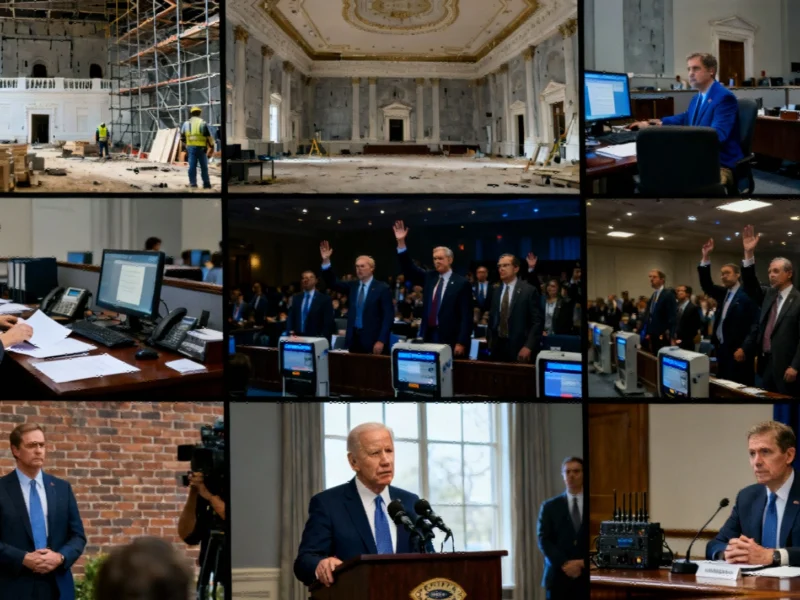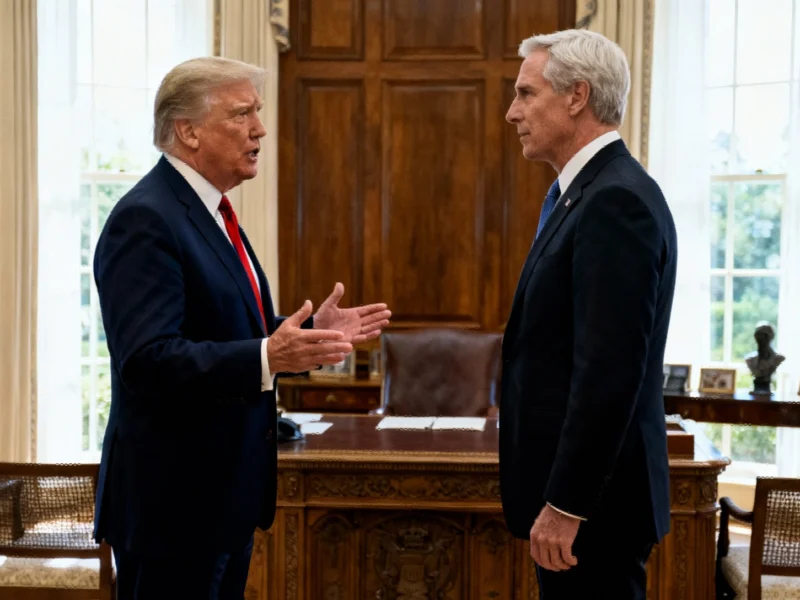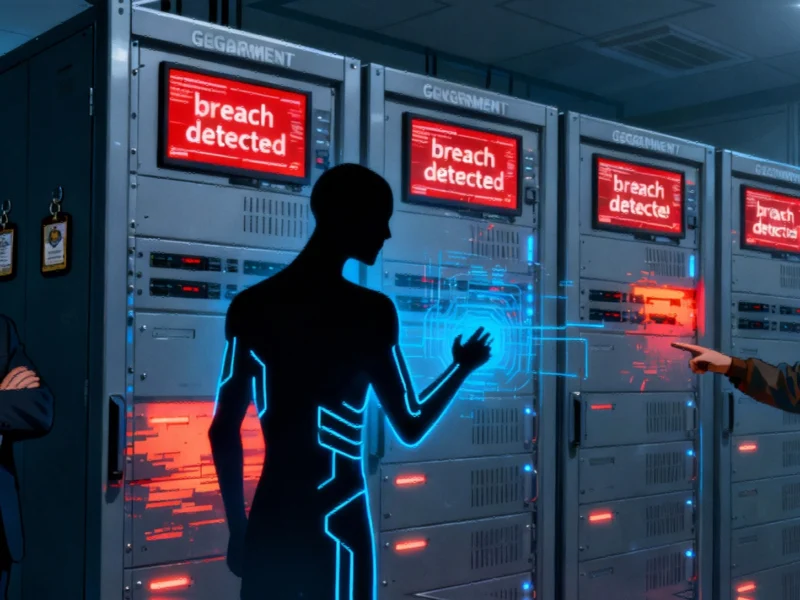Government Shutdown Extends Amid Political Standoff
The partial government shutdown has entered its 16th day as the Senate rejected the Republican-backed continuing resolution for the 10th time, according to congressional records. The failed vote maintains the political impasse that began October 1, with Democrats and Republicans continuing to trade accusations over responsibility for the funding lapse.
Administration Priorities Protected During Shutdown
Meanwhile, the Trump administration has preserved some of its key priorities during the shutdown, sources indicate. Construction of a White House ballroom continues, with an unnamed administration official telling ABC News the project is not funded by congressional appropriations. According to Politico analysis of internal government documents, offices handling tariffs and immigration enforcement will retain more staffing than in previous shutdowns.
Vice President JD Vance rejected the notion the Trump administration was purposely maneuvering funding to punish Democrats, telling reporters during a White House briefing Wednesday “we’re not targeting federal agencies based on politics.” However, House Speaker Mike Johnson contradicted this position, stating during a press conference that “the longer this goes on, the more pain will be inflicted” and telling radio host Moon Griffon the shutdown could “benefit” Republicans by allowing additional cuts to the federal workforce.
Legislative Impasse Continues
The Senate failed to approve Republican-backed legislation known as a “continuing resolution” that would have staved off the shutdown by allowing the government to operate under its existing budget through November 21. The measure was rejected in a 55-45 vote, falling short of the 60-vote threshold needed to pass the Senate, with three members of the Democratic caucus voting alongside Republicans. The House had already passed the GOP-backed proposal in a 217-212 vote, but it needed the support of at least seven Democrats to move through the Senate.
The major factor dividing Republicans and Democrats appears to be Democrats’ demand for an extension of federal tax credits under the Affordable Care Act set to expire at the end of the year. Republicans have accused Democrats of forcing a shutdown and alleged they want undocumented immigrants to have access to public healthcare benefits, though analysts note most undocumented immigrants are not legally eligible for such programs.
Widespread Federal Worker Furloughs
The Congressional Budget Office stated in a letter last week to Senator Joni Ernst that 750,000 workers could be furloughed daily during the shutdown, with their compensation totaling $400 million. Several agencies have indicated they will furlough more than half their workers, including the Environmental Protection Agency (89%), the Education Department (87%) and Commerce (81%), according to The New York Times.
Key economic data collection activities from the Labor Department have been suspended, meaning Friday’s Bureau of Labor Statistics report on nonfarm payroll growth was not released. Weekly reports on jobless claims and potentially the next consumer price index report scheduled for October 15 could also be paused. Some federal agencies, such as the federal housing administration, would stop processing new loans, and routine inspections by the Food and Drug Administration and EPA would be curtailed or stopped.
Essential Services Continue Operation
Mandatory programs, such as Social Security, Medicare and Medicaid, veterans’ disability and pension payments and federal student loans will continue making payments. Food assistance programs, including SNAP and the federal program to assist women, infants and children, are also exempt, “subject to the availability of funding,” according to the U.S. Department of Agriculture contingency plan.
Other programs funded by fees, rather than annual congressional appropriations, will operate normally, including the U.S. Postal Service and passport and visa processing. Essential employees, including active military personnel and air traffic controllers, are required to continue working. Some activities related to public health, including monitoring for disease outbreaks and foodborne illness, are also exempt from the shutdown.
National parks will remain open, but most National Park Service staff will be furloughed, with the exception of personnel performing “activities necessary to protect life and property” and those required by law, according to Interior Department Guidance. The Smithsonian Institution said its museums and National Zoo will remain open through at least October 6 using funding from the previous year.
Political Blame Game Intensifies
In a post on X, Senate Minority Leader Chuck Schumer wrote: “IT’S MIDNIGHT. That means the Republican shutdown has just begun because they wouldn’t protect Americans’ health care. We’re going to keep fighting for the American people.” Schumer also issued a joint statement with House Minority Leader Hakeem Jeffries, which read: “After months of making life harder and more expensive, Donald Trump and Republicans have now shut down the federal government because they do not want to protect the healthcare of the American people.”
Representative Jamie Raskin tweeted: “MAGA’s government shutdown was totally avoidable, and I will keep fighting hard to get government back open.” Representative Jasmine Crocket wrote: “Make no mistake: Republicans control the House, the Senate, and the White House. This is THEIR shutdown. They had every tool to govern and chose chaos instead.”
In contrast, Speaker Johnson wrote on X: “Democrats have officially voted to CLOSE the government. Results: Moms and kids now lose WIC nutrition. Veterans lose health care and suicide prevention programs. FEMA has shortfalls during hurricane season. Soldiers and TSA agents go UNPAID.” The White House’s official website now displays a government shutdown clock and a running chyron which says: “Democrats Have Shut Down the Government.”
Trump Administration Threats and Strategy
Trump told Politico “I don’t worry about that” when asked if he fears Americans will blame Republicans for a shutdown. Calling Democrats “deranged,” Trump claimed they “want to destroy healthcare in America by giving it to millions and millions of illegal aliens,” according to Politico reporting.
The Office of Management and Budget also instructed federal agencies to formulate plans for mass layoffs in a shutdown by identifying programs whose discretionary funding expire on October 1, along with those that don’t align with Trump’s agenda. The move was widely viewed as a way to exact maximum pain on Democrats if they refuse to agree to Republicans’ proposal to avert a shutdown. Schumer called the threat to fire federal workers if the government shuts down “an attempt at intimidation” in a statement.
Potential Political Consequences
Democrats could benefit politically from forcing a shutdown, according to political experts, who have noted it’s one of the few tools they have to counter Republicans, who control all three branches of government. It’s considered a risky move as shutdowns are generally unpopular with voters, analysts suggest.
In recent previous shutdown negotiations, a small coalition of right-wing Republicans have threatened to withhold their votes if the new spending plan doesn’t adhere to their demands, while Democrats have typically been averse to shutdowns. Democrats, polling at their lowest level in history according to Gallup, potentially have an opportunity to use the shutdown negotiations as a show of resistance to the Trump administration.
The last time the government shut down, during Trump’s first term in December 2018, it was the longest shutdown on record, lasting 35 days. At the center of the dispute was Trump’s demand for more border wall funding, which he eventually abandoned to allow the government to reopen.
Tourism officials estimate that disruptions in air and rail travel and national parks and museum closures could cost the economy $1 billion during a shutdown, according to industry analysis.
This article aggregates information from publicly available sources. All trademarks and copyrights belong to their respective owners.



